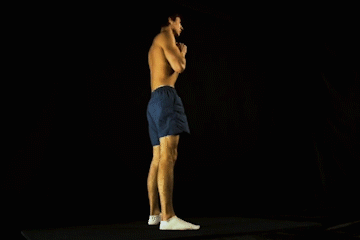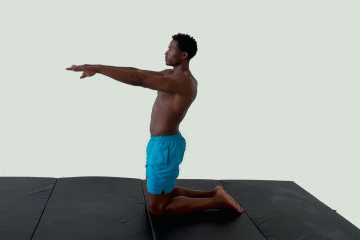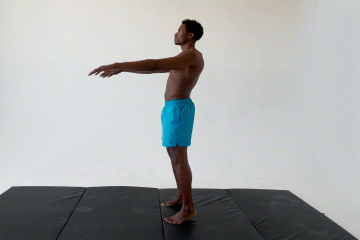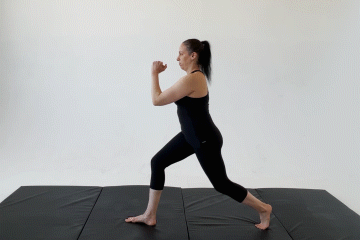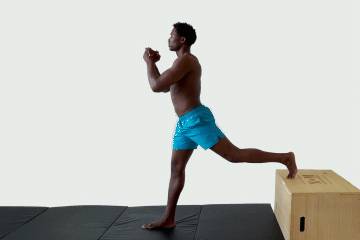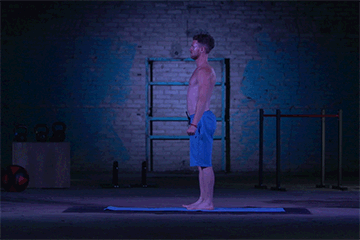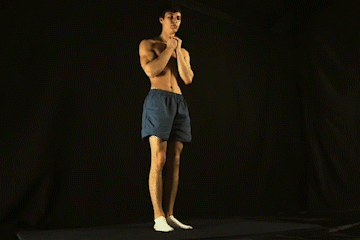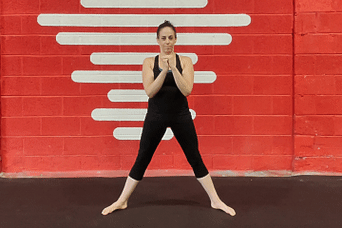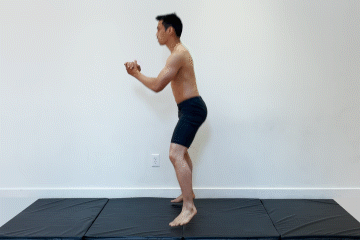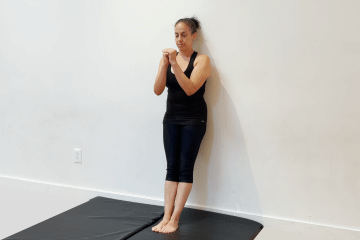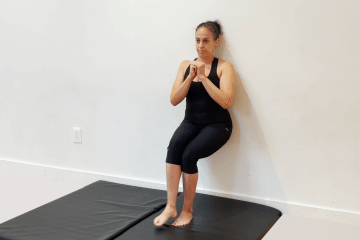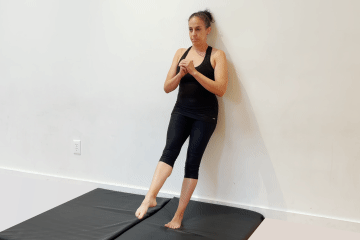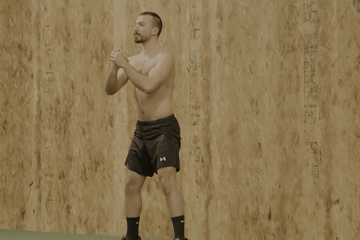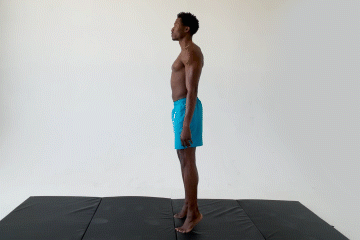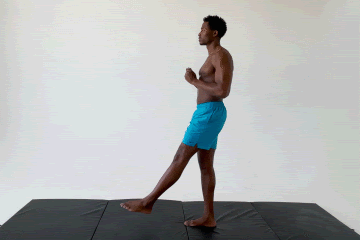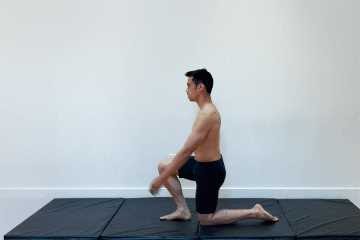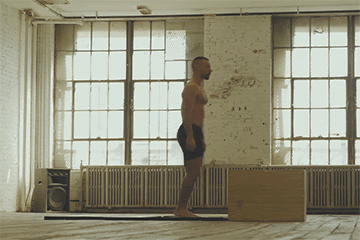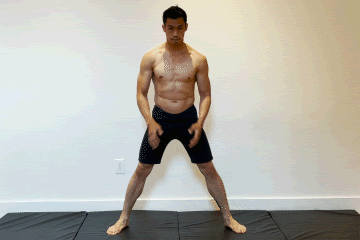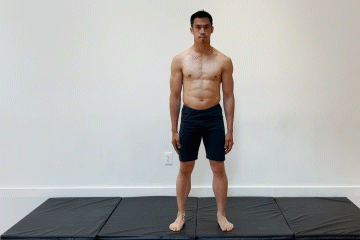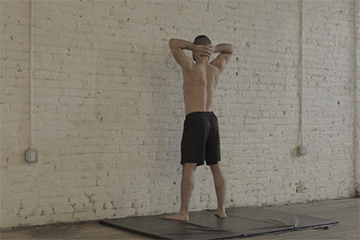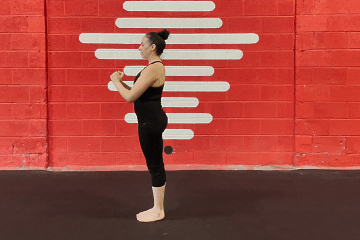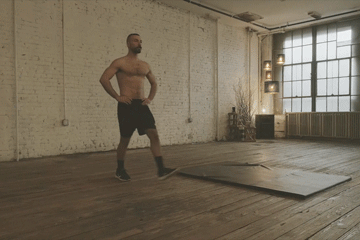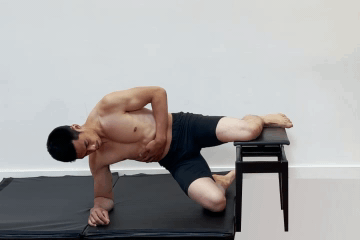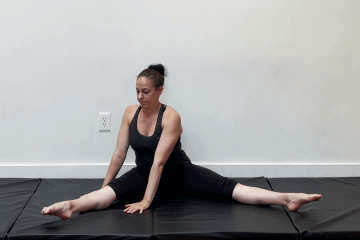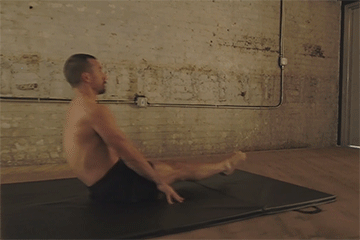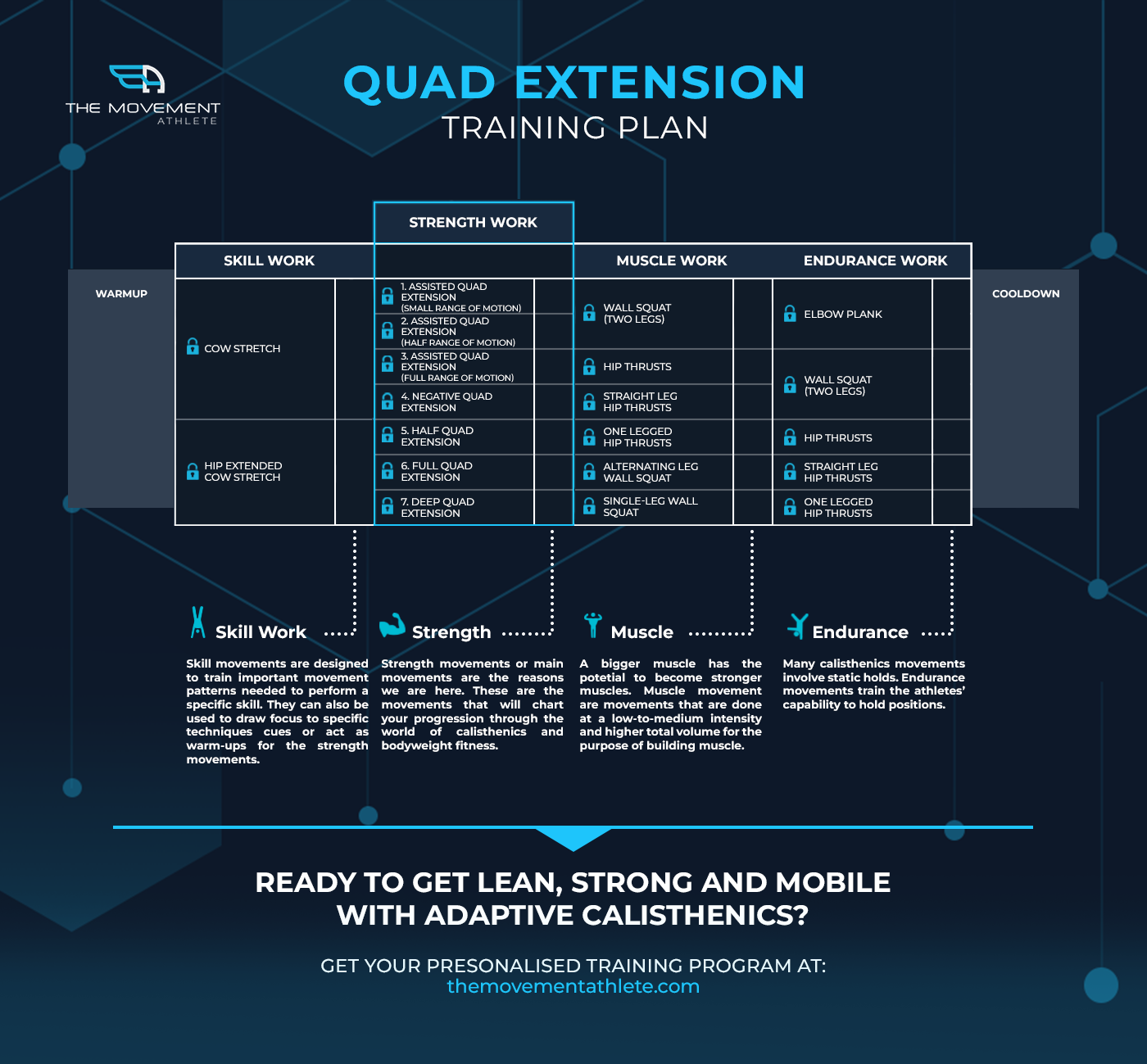Do you want to improve the strength and health of your lower body? If so, you need to be doing quadriceps exercises. The best part is that you can do these exercises anywhere – no equipment required! Calisthenics quad exercises are more than enough to guarantee you strong and healthy legs.
📌Summary:
In this article, we will discuss the following topics:
- 🔎 Anatomy of the quads
- 🔎 The functions of the quads
- 🔎 List of 26 bodyweight quadriceps exercises
- 🔎 The top 10 exercises
- 🔎 The Ultimate quad exercise in our opinion
- 🔎 & Frequently Asked Questions regarding these topics
If you need a complete list of the leg exercises to get a full lower body workout, check out this article: 📍101 Bodyweight Leg Exercises: The Ultimate List
🧐What is the quadriceps?
The quadriceps is a large muscle group that covers the front and sides of your thigh. It’s one of the most powerful muscle groups in your body and is responsible for extending your knee.
Based on the name (quad = four, ceps = heads), quadriceps consists of four headed muscles: bicep femoris, rectus femoris, vastus intermedius, and vastus medialis. The full name of the muscle is quadriceps femorii. Femorii means femur or the thigh bone. In fact, the heads originate from the femur.
These four muscles work together to extend your knee. That means it’s involved in activities such as walking, running, climbing stairs and squatting. Strong quadriceps can help to prevent injuries and improve your overall performance in these activities.
🤔Why should I train my quads?
Based on the functions of the quads, you’ll immediately notice the reason why you need to train them. Although they are naturally strong since we regularly use them when standing, walking, and sitting down, you still need to put extra emphasis on that muscle group to prevent any weaknesses, especially if you have a sedentary workload.
Training your quads can help you to:
- ✔️ Improve your athletic performance
- ✔️ Prevent injuries in the lower body
- ✔️ Prevent & reduce knee pain
- ✔️ Build strong and aesthetic legs
- ✔️ Improves overall physique
- ✔️ Strong, mobile lower body
- ✔️ Improved overall daily movements
💥26 Bodyweight Quadriceps Exercises
👊Regular Squats – Beginner
Regular, bodyweight squats are one of the best exercises to work your quads. Although it works glutes, especially when your knees go past 90 degrees and your hamstrings to some extent, your quads have the most activation in this exercise. Because in squats, you need to work on pushing against your body weight to extend your knees.
The two-legged squat offers a great foundation of both strength, mobility, and muscle development as you go stronger in your calisthenics workouts.
👊Kneeling quad extension – Scalable
Kneeling bodyweight quad extension is simply the best isolation quad exercise for building size, strength, and mobility. The movement pattern trains the knee extension, which is the primary role of the quads.
The quad extension is popular in the gym for quad development. But not everyone has access to the gym equipment, and gym memberships can also be expensive. Hence, the quad extension provides a great option for building your quads.
👊Sissy squats – Advanced
This exercise is highly underrated and gained notoriety because of the outdated adage, “don’t squat past your toes.” But, yes, you CAN SQUAT PAST YOUR TOES. It’s a safe movement pattern that can further improve your quads and strengthen your knees IF done correctly and you are not rushing through the proper progressions.
Don’t let the name fool you. The sissy squat is very challenging and can take some time to master. But the sissy squat journey provides excellent value and should be considered in your workout if you want bigger quads.
👊Lunges- Beginner
The lunge is a unilateral exercise that works similarly to the regular squats. The non-working leg acts to balance and lessen the load while you work on the other leg. Lunges are flexible since you can step closer to target your glutes, but you can also step further to emphasize your quads. The idea is to step so that when you go down, your shin is perpendicular to the floor. This exercise is excellent for beginners who already have mastered the regular squats.
👊Bulgarian Split-squat – Intermediate
This variation of lunges elevates the non-working leg, so you put more emphasis on the working leg. The elevated leg works more for balance rather than stability, like in the lunges. The same concept applies to Bulgarian split squats to emphasize the quads.
👊Shrimp squat – Intermediate
The shrimp squat is close to a pistol squat but requires less mobility as you don’t need to go in deep like in pistol squats. In addition, the non-working leg limits the range of motion, but this exercise is still very challenging as the full weight is on a single leg. You would also need to stabilize yourself before executing the exercise fully.
👊Close squat – Intermediate
A 2009 research shows that a narrow squat stance put more emphasis on your quad muscles. This is why a close squat is a great option for building your quads once you have mastered the regular squat with a shoulder-width stance.
👊Wide squat – Intermediate
A wide squat put more emphasis on your glutes. However, it still offers a good benefit of hitting your quads while improving hip mobility for general leg development.
👊Lunge complex – Intermediate
The lunge complex trains coordination, explosiveness, and endurance all in one exercise. There’s a heavy quad emphasis since the exercise consists of a regular lunge and a squat that both target the quads. You would need to have mastered both exercises before attempting the sequence.
👊Wall squat – Beginner
Wall squat is an isometric quad isolation exercise. It trains the quads in an extended position since you would need to fight your body weight and gravity while leaning on the wall. It’s perfect for beginners who are just starting out since mobility isn’t going to be much of an issue in executing the exercise.
👊Alternating wall squat – Intermediate
From the two-legged wall sits, alternating into a single-leg offers an intense blast on your quads while correcting weaknesses on your non-dominant leg.
👊Single-leg wall squat- Advanced
This variation holds the exercise in a single leg for an extended period of time. Compared to the alternating variation above, the single-leg wall squat keeps you challenged without rest, making it a more difficult quad-heavy exercise.
👊Deep squat – Intermediate
Deeps squats stretch your quads while also challenging them through the range of motion. It’s perfect for both muscle-building and mobility work. When you get advanced enough, deep squats can be used as a warm-up exercise for more challenging squat variations such as the pistol squats.
👊Hindu squats – Intermediate
Hindu squat is similar to the deep squat, but since your heels are raised off the floor, and you’re on your toes, it shifts the emphasis more into your quads instead of the glutes. It also stretches your quads more because the elevated heel position shifts the weight forward towards your quads. Again, this is another good variation after mastering the regular squats.
👊Pistol squats- Advanced
Of course, the pistol squat is a popular option for lower body development for intermediate to advanced athletes after the squats. This complex exercise requires a solid combination of mobility, balance, control, and strength to be able to perform it well.
Pistol squats are a go-to exercise if you want to build overall general leg strength and should be your primary focus for calisthenics leg training.
👊Skater squat – Intermediate
This single-leg variation is another good option to build strong legs while requiring less mobility than pistol squats. The skater squat can be considered an easier variation of shrimp squats since you have more balance with your hands in front of you.
👊Step-ups – Scalable
Step-ups are an excellent single-leg exercise for general leg strength and quad domination. It also works similar to a pistol squat but requires you also with less mobility than the pistol but more hip mobility compared to the skater and shrimp squat. Step-ups are very accessible since you just need an elevated surface to perform the exercise. The higher the elevation, the harder the exercise gets. It’s scalable for all fitness levels.
👊Cossack squat – Intermediate
Cossack squat or side-to-side squat is fantastic for increasing your overall lower body mobility. It has already a strong emphasis on your quads while also hitting the abductor muscles. Cossack squat is also great if you want to work towards side splits and similar movements that require the straddle position.
👊Bosu ball squat – Intermediate
Although this requires you have access to a Bosu ball, this is still a good option to build quads. The additional instability that the Bosu ball provides requires you to stabilize yourself in order to execute the movement. This exercise also trains your balance and coordination.
👊Curtsy squat- Advanced
Curtsy squat is a unilateral exercise that hits the quad while also hitting your glutes and hip muscles. This exercise trains your mobility and coordination, perfect for complicated movement patterns in other disciplines such as dancing and other team sports.
👊Wall squat descent- Beginner
This exercise is great for maintaining good form with the wall guiding the descent. Wall squat descents, like the regular squats, hit the whole lower body but emphasize the quads, especially at the top portion of the movement until when your knees are at a 90-degree angle.
👊Reverse lunges- Beginner
Lunges moving backward is perfect for adding spice and coordination to your regular lunges. It works similarly to regular lunges, but the backward movement requires you to stay more focused on your movement.
👊Walking lunges- Beginner
Walking lunges alternates your leg while moving forward. This exercise transfers to many movement patterns, such as running and sprinting, where you move forward as you produce force.
👊Adductor bridge – Scalable
The adductor bridge exercise doesn’t directly target the quads, but we included this exercise since it hits the adductor muscles, which helps stabilize the quads. This move also hits your quads for stronger lower body development in general.
👊Straddle leg lifts – Scalable
For more specific mobility requirements, straddle leg lifts are the way to go. Especially if you’re working towards specific calisthenics moves such as straddle press to handstand and straddle L-sits. This is a very challenging exercise as looks a lot easier than it looks. Expect heavy cramping when first working with this move.
👊Pike leg lifts – Scalable
Similar to the straddle leg lifts, this move follows the same benefits and movement pattern but is performed with piked legs. The piked leg position helps you improve the quad mobility in the pike position for exercises like the full pike press to handstand and full L-sits. It’s arguably heavier than the straddle variation, but the straddle leg lifts tend to be more difficult for most people due to the open hip position.
🔥Top 10 Quad Exercises
With fairly a number of excellent quad exercises, you might get overwhelmed with which exercises to implement in your workout.
As a general rule, incorporating compound exercises is the priority. So be sure to include at least one squat variation or step-up as your primary leg exercise. Then while these exercises put a good emphasis on your quads, be sure to add at least one quad-isolation movement to further overload your quads for maximum growth.
Here are our 10 Go-To exercises for building stronger, bigger, and more mobile quads:
🎯Compound but quad-heavy exercises:
- 💪 Regular squats
- 💪 Pistol squats
- 💪 Skater squat
- 💪 Step up
- 💪 Bulgarian lunges
- 💪 Side-to-side squat
- 💪 Jump squat (explosive)
⚡️Quad isolation exercises
- ✅ Sissy squat
- ✅ Quad extensions
- ✅ Wall squat
Read more: 📍10 Most Effective Bodyweight Quad Exercises
💯The Best Isolation Quad Exercise: Bodyweight Quad Extensions
Among all the quad exercises, the bodyweight quad extension reigns champion in quad development. The exercise can both strengthen and mobilize your quads and is completely scalable from beginners to advanced.
The quad extension also has a high quad activation and does not rely too much on other muscles, so you can completely overload your quads after your main lower body compound exercise.
🏆Quad extension progression
Not everybody is born already capable of performing quad extensions. This is why we follow a solid progressive calisthenics approach when learning the skill.
Here is the quad extension progression from beginner to advanced. At the later stages, you can opt for a weighted variation to further increase the loading on your quads.
👊Strength Element
The strength element offers to strengthen the quadriceps towards the full range of motion of the bodyweight quad extension exercise. Take note that this move is also amazing for also improving your quads’ mobility.
Assisted Quad Extension (Small Range of Motion)
Assisted Quad Extension (Half Range of Motion)
Assisted Quad Extension (Full Range of Motion)
Negative Quad Extension
Half Quad Extension
Full Quad Extension
Deep Quad Extension
🤸Skill Element
Quad extensions do have a mobility requirement. You will most likely be restricted at the beginning with your hips or your quads itself so these stretches allow you to improve your range of motion as you prepare for the quad extension exercise.
Cow stretch
Hip Extended Cow Stretch
💪Muscle Element
Bigger muscles show potential for stronger muscles. This set of exercises is lower intensity compared to the quad extension so you can build up the good training volume to improve your quad muscles and other surrounding areas that might limit your potential for quad development.
Wall Squat (Two Legs)
Hip thrusts
Straight leg hip thrusts
One-legged hip thrusts
Alternating Leg Wall Squat
Single-Leg Wall Squat
🏃Endurance Element
You might notice the elbow plank in the endurance element. This is because you’ll need to hold your core tightly when performing the quad extension. You don’t want to get limited with the training capacity of your core to be able to load your quads directly.
Elbow plank
Elbow plank
Wall Squat (Two Legs)
Hip thrusts
Straight leg hip thrusts
One-legged hip thrusts
🤔Frequently Asked Questions:
🔎How do add quad exercises to your workout?
As mentioned before, the compound exercises such as squats should be your top priority for overall leg development. Even after using them and even after they are already quad-dominant, only then you can move to your preferred quad accessory exercise. You can add one to two quad exercises since you already have done a lot from your squats.
After performing your squat variation, you can do your quad extension for 3 sets of 6 – 12 reps with 90-120 seconds of rest. Adjust the variation based on your skill level.
If you’re looking for more in-depth leg workouts, check out this article: 📍Calisthenics Leg Workout
🔎Why not JUST the squats?
Squats are fantastic for developing your quads. In fact, a 2017 EMG analysis shows that squats have a heavy emphasis on the quads, especially with the single-leg variation.
However, squats still are considered a heavy compound exercise which means that the glutes and hamstrings are also heavily involved in the movement. Therefore, squats should still be a top priority for lower body development, but additional accessory exercises to emphasize the quad muscle group are still needed for maximum development, especially if you want to build size.
Hence, exercises like sissy squats and bodyweight quad extensions are great options to supplement your squat training.
🔎Can running build bigger quads?
While running can certainly help to build and tone the quads, it is not the most effective exercise for doing so. This is because running is a cardio exercise that primarily works the muscles in the legs and hips. Therefore, if you want to build bigger quads, you need to be doing resistance exercises that specifically target the quadriceps muscle group. This includes the movements mentioned above.
On the other hand, uphill sprints can develop bigger quads with the added difficulty of the incline and high intensity combined, as exhibited in a 2022 study conducted by Nuell & colleagues.
🔎Does cycling strengthen the quads?
Another option is opting for cycling if you enjoy the sport and the outdoors. However, cycling still favors a more cardio endurance benefit and muscular increase is at a slower rate compared to your regular resistance training. If you do enjoy the sport, you can opt for this instead of calisthenics or do both for better gains!
🔎Do I need to stretch my quads?
Stretching depends on the context. If we’re talking about passively stretching the quads for an extended period of time with assistance, then it’s not necessary. It can help in improving flexibility, but it will not strengthen your quads to move in a wider range of motion.
If you want to stretch the quads in a loaded manner, such as performing quad extensions, then you will enjoy the maximum benefits of strengthening and mobilizing exercises.
More on this topic here: 📍Flexibility vs Mobility
🔎Should I avoid the sissy squat?
The sissy squat is one of the best exercises you can do for your quads and knees. Unfortunately, this exercise gained notoriety due to the outdated sentiments of squatting “within your toes.” Sissy squat is not only safe but an effective way to build your quads and strengthen your knees!
Every exercise is dangerous if you don’t prepare for it and just jump right into it. The same goes for the sissy squats. Be sure to opt for a suitable progression based on your skill level and that you have already mastered the basic squat.
🔎How to build bigger quads?
People tend to gravitate towards weightlifting when building the lower body. I can’t blame them. It is a very effective approach. However, 📍calisthenics can also build muscle granted that the proper protocols are performed based on your skill level.
It’s possible to build bigger legs with calisthenics. Just be sure you’re training progressively, getting enough rest, and eating enough. It’s actually very simple!
📌Takeaway
There are a variety of ways to build bigger quads. The best approach is to find an activity or sport that you enjoy and stick with it. If you want to focus on building your quads specifically, then be sure to include exercises that target the quadriceps muscle group such as sissy squats and bodyweight quad extensions to your workout.
Your quads are generally strong, but if you want to use them to their maximum capacity, then mobilizing and strengthening them is a must!
Building powerful and strong legs require proper programming, especially if you want to train with a calisthenics approach. Not all programs are created equal since you need to tailor your program to your skill level and needs to maximize results.
Train the smart way and use a personalised and adaptive calisthenics approach to maximize your results in every session!
GET YOUR 7-DAY FREE PERSONALISED TRIAL PROGRAM NOW!🏆

